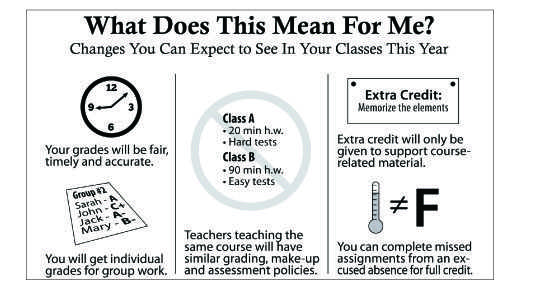
[Graphic by Rebecca DeShetler]
Teachers spent time toward the end of last school year and over the summer to align courses, an action that was prompted by the Grades/Evaluation of Student Achievement Policy. The policy, which was passed April 23 of this year, ensures that students receive grades in an efficient manner and that each individual student has an equal chance of receiving a grade that accurately reflects the student’s achievement in the class, regardless of the teacher. In other words, assessment of a student will be similar no matter who the teacher.
The policy was created after the Assessment Task Force, a 25-member group consisting of students, parents, teachers and administrators from both Los Altos High School (LAHS) and Mountain View High School (MVHS), showed interest in aligning classes. This idea grew out of the Western Association of Schools and Colleges (WASC) self-study that took place at the school.
“Out of that self-study, Los Altos High School determined that one of their greatest challenges was the lack of alignment among teachers teaching the same courses,” Assistant Superintendent of Educational Services Brigitte Sarraf said. “So Los Altos had been working literally for nine years on wanting to achieve greater alignment and has made great progress every single year. The Achievement Policy came about in part of what Los Altos had been finding as a result of their self-study and their review.”
Teachers got together in course teams consisting of teachers instructing a particular class to determine lesson plans and assignment requirements. They worked to make sure the assignment requirements were the same, so that a student in a course with one teacher had an equal chance of obtaining the same overall grade in the class as a student in the same course with another teacher. For example, all United States History teachers came together to ensure that their lessons covered a similar syllabus and formed a plan to give out the same assignments so that all assignments in the gradebook would be the same even if teachers were different. They also made category weights the same.
The course team produced one course information sheet that was distributed to each student enrolled in the class. In the past, each teacher had created their own course information sheets.
“There can be some differences in the delivery of the curriculum but … if you are in United States History, it comes with a guarantee that it doesn’t matter whose class you’re in, you get the same curriculum and you are being assessed in the same manner,” Sarraf said.
The Assessment Task Force gave course teams guidelines and requirements that needed to be discussed and implemented. Some of these requirements included common grading policies, late work policies and extra credit policies.
During the two in-service days before school started, the English Department discussed these policies. The English Department as a whole is very much aligned, as Survey of Composition and Literature has been aligned for about 15-20 years.
“I would say for this year none of the discussion was hard because we were already there [at alignment], but in the past some of the conversations that were really challenging were grading philosophies,” English Department Coordinator Keren Robertson said. “We would have one person in the department who had eight or nine grades per semester because they really believed in holistic grading whereas there were other people in the department [who] were more used to kind of putting a grade on every single thing, so they would end up with 60 or 70 assignments by the end of the semester. [It was hard] to figure out how to come up with a policy that everyone can agree on.”
Alignment can also be difficult for courses where teachers haven’t necessarily had enough time to have discussions about assessment policies.
“I do think it is very challenging to get teachers to agree because they have strongly held philosophies so I just think that for it in order to be done well, there needs to be a lot of time built in for dialogue and conversation to help people understand,” Robertson said. “That’s the only challenge for departments who are working towards alignment.”
While LAHS course teams focused on alignment for classes in terms of achievement (grading scales), MVHS course teams decided to take it further and attempted to devise a grading system that addresses a more equally distributed grading scale. Teams produced a four-point grading scale in which each interval between a four, three, two and one is equal. With the original grading scale, an F entitles work anywhere between zero to 59 percent, a greater interval than the A, B, C and D grades which have only a 10 percent range. The four point grading system is being used by certain course teams–particular courses–at MVHS, not LAHS. The Achievement Policy’s purpose is not to align MVHS and LAHS, but rather to align courses at the same school.
In order to check if the assessment policy is being implemented properly, the district plans to re-evaluate the policy after first and second semester. However, according to Sarraf, teachers will not be expected to have full alignment by the end of first semester.
“The implementation process is going to happen over the course of the year, so we won’t know until the end of the year whether the policy is actually working or not.” Sarraf said. “… We’re going to start looking at it next semester and see so that we can redirect our resources and our energy to make sure that the spirit of the policy and the letter of the law are being adhered to and respected. If it doesn’t work, if we run into some problems, then we want to change things.”








